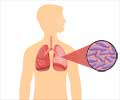The structure of a novel protein in the bacterium that is the most persistent pathogen in cystic fibrosis (CF) patients has been solved.
The structure of a novel protein in the bacterium that is the most persistent pathogen in cystic fibrosis (CF) patients has been solved.
Hauptman-Woodward Institute scientists Dr. Andrew Gulick, Eric Drake and Dr. Manish Shah, in collaboration with researchers at the University at Buffalo and the New York State Center of Excellence in Bioinformatics and Life Sciences have made this significant discovery which was published in the current issue of the Journal of Biological Chemistry.The study is the first structural characterization of this novel protein that is present in many bacteria including the pathogen that causes tuberculosis.“It's well-known that bacteria need iron to grow and, when they are establishing an infection, they steal iron from the host.
To do this, they make complex molecules that bind tightly to the iron. We have determined the structure of a protein that is essential to produce normal amounts of one of these complex molecules in Pseudomonas. What is interesting is that other bacteria use a very similar protein and we assume the proteins will be essential there as well.
This work gives us clues to the role of this protein and we hope that future studies will identify the precise role that may provide an opportunity to disable this protein and may identify a new antibiotic that could limit the infections that can be fatal in CF patients,” Gulick said.
Work from other labs has identified the proteins that are essential to make pyoverdine, the compound that Pseudomonas produces to obtain iron. Some of these proteins are essential, yet the role they play is unknown. The Gulick lab has determined the molecular structure of PA2412, one of these uncharacterized proteins.
The structure of this protein molecule is unlike any previously characterized protein and the lab is now performing additional studies that will more completely identify the role and hopefully ways that the activity can be blocked.
Advertisement
He added that the research was enhanced by the HWI group’s collaboration with Dr. Jun Qu, research assistant professor, Dr. Robert M. Straubinger, professor, both in UB School of Pharmacy and Pharmaceutical Sciences and Dr. Jin Cao, research scientist in the UB Center of Excellence.
Advertisement
Source-Eurekalert
JAY/M











